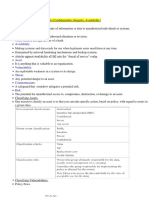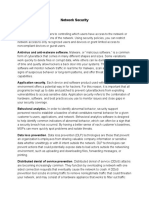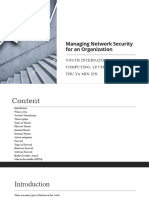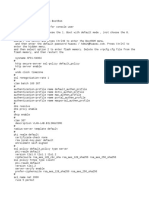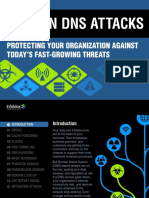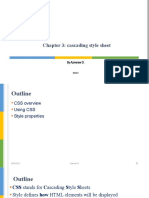Module 4. Protecting The Organization
Uploaded by
485victorModule 4. Protecting The Organization
Uploaded by
485victorSecurity Appliances
Security appliances can be standalone devices like a router or software tools that are run on a
network device. They fall into six general categories:
1. Routers-used to interconnect various network segments together and also provide basic
traffic filtering capabilities.
2. Firewalls- is a network security device that monitors and filters incoming and outgoing
network traffic based on an organization's previously established security policies
3. Intrusion prevention systems- IPS systems use a set of traffic signatures that match
and block malicious traffic and attacks.
4. Virtual private networks-VPN systems let remote employees use a secure encrypted
tunnel from their mobile computer and securely connect back to the organization’s
network.
5. Antimalware or antivirus-use signatures or behavioral analysis of applications to
identify and block malicious code being executed.
Firewalls
A firewall is designed to control or filter which communications are allowed in and which are
allowed out of a device or network.
Types:
1. Network layer firewall-This filters communications based on source and destination IP
addresses.
2. Transport layer firewall-Filters communications based on source and destination data
ports, as well as connection states.
3. Application layer firewall-Filters communications based on an application, program or
service.
4. Context aware firewall-Filters communications based on the user, device, role,
application type and threat profile.
5. Proxy server-Filters web content requests like URLs, domain names and media types.
6. Reverse proxy server-Placed in front of web servers, reverse proxy servers protect,
hide, offload and distribute access to web servers.
7. Network address translation (NAT) firewall-This firewall hides or masquerades the
private addresses of network hosts.
8. Host based firewall-Filters ports and system service calls on a single computer
operating system.
Port scanning
Port scanning is a process of probing a computer, server or other network host for open ports. It
can be used maliciously as a reconnaissance tool to identify the operating system and services
running on a computer or host, or it can be used harmlessly by a network administrator to verify
network security policies on the network.
Intrusion Detection and Prevention Systems
Intrusion detection systems (IDSs) and intrusion prevention systems (IPSs) are security
measures deployed on a network to detect and prevent malicious activities.
Protection against malware
One way of defending against zero-day attacks and advanced persistent threats (APTs) is to
use an enterprise-level advanced malware detection solution, like Cisco’s Advanced Malware
Protection (AMP) Threat Grid.
Benefits Of Cisco's Threat Grid:
1. Secure operations center team-The Threat Grid allows the Cisco Secure Operations
Center team to gather more accurate, actionable data.
2. Incidence response team-The Incidence Response team therefore has access to
forensically sound information from which it can more quickly analyze and understand
suspicious behaviors.
3. Threat intelligence team-Using this analysis, the Threat Intelligence team can
proactively improve the organization’s security infrastructure.
4. Security infrastructure engineering team-Overall, the Security Infrastructure
Engineering team is able to consume and act on threat information faster, often in an
automated way.
Security best practices:
1. Perform risk assessment-Knowing and understanding the value of what you are
protecting will help to justify security expenditures.
2. Create a security policy-Create a policy that clearly outlines the organization’s rules,
job roles, and responsibilities and expectations for employees.
3. Physical security measures-Restrict access to networking closets and server
locations, as well as fire suppression.
4. Human resource security measures-Background checks should be completed for all
employees.
5. Perform and test backups-Back up information regularly and test data recovery from
backups.
6. Maintain security patches and updates-Regularly update server, client and network
device operating systems and programs.
7. Employ access control-Configure user roles and privilege levels as well as strong user
authentication.
8. Regularly test incident response-Employ an incident response team and test
emergency response scenarios.
9. Implement a network monitoring, analytics and management tool-Employ an
incident response team and test emergency response scenarios.
10. Implement network security devices-Employ an incident response team and test
emergency response scenarios.
11. Implement a comprehensive endpoint security solution-Use enterprise level
antimalware and antivirus software.
12. Educate users-Provide training to employees in security procedures.
13. Encrypt data-Encrypt all sensitive organizational data, including email.
Behavior-based security
Behavior-based security is a form of threat detection that involves capturing and analyzing the flow of
communication between a user on the local network and a local or remote destination. Any changes in
normal patterns of behavior are regarded as anomalies, and may indicate an attack.
Types:
1. Honeypots-honeypot is a behavior-based detection tool that lures the attacker in by appealing
to their predicted pattern of malicious behavior. Once the attacker is inside the honeypot, the
network administrator can capture, log and analyze their behavior so that they can build a
better defense.
2. Cisco’s cyber threat defense solution archicture- this security behavior-based detection and
indicators to provide greater visibility, context and control. The aim is to know who is carrying
out the attack, what type of attack they are performing and where, when and how the attack is
taking place.
Netflow
NetFlow technology is used to gather information about data flowing through a network,
including who and what devices are in the network, and when and how users and devices
access the network.
Penetration testing
Penetration testing, commonly known as pen testing, is the act of assessing a computer system, network
or organization for security vulnerabilities. A pen test seeks to breach systems, people, processes and
code to uncover vulnerabilities which could be exploited. This information is then used to improve the
system’s defenses to ensure that it is better able to withstand cyber-attacks in the future.
Steps:
1. Planning-The pen tester gathers as much information as possible about a target system
or network, its potential vulnerabilities and exploits to use against it. This involves
conducting passive or active reconnaissance (footprinting) and vulnerability research.
2. Scanning-The pen tester carries out active reconnaissance to probe a target system or
network and identify potential weaknesses which, if exploited, could give an attacker
access. Active reconnaissance may include:
port scanning to identify potential access points into a target system
vulnerability scanning to identify potential exploitable vulnerabilities of a
particular target
establishing an active connection to a target (enumeration) to identify the user
account, system account and admin account.
3. Gaining access-The pen tester will attempt to gain access to a target system and sniff
network traffic, using various methods to exploit the system including:
launching an exploit with a payload onto the system
breaching physical barriers to assets
social engineering
exploiting website vulnerabilities
exploiting software and hardware vulnerabilities or misconfigurations
breaching access controls security
cracking weak encrypted Wi-Fi.
4. Maintaining access-The pen tester will maintain access to the target to find out
what data and systems are vulnerable to exploitation. It is important that they
remain undetected, typically using backdoors, Trojan horses, rootkits and other
covert channels to hide their presence. When this infrastructure is in place, the
pen tester will then proceed to gather the data that they consider valuable.
5. Analysis and reporting-The pen tester will provide feedback via a report that recommends
updates to products, policies and training to improve an organization’s security.
Actions Organizations Should Take When a Security Breach Is Identified:
1. Communicate the issue
2. Be sincere and accountable
3. Provide the details
4. Find the cause
5. Apply lessons learned
6. Check and check again
7. Educate
CISCO’S CSIRT (COMPUTER SECURITY INCIDENT RESPONSE TEAM.
Many large organizations have a Computer Security Incident Response Team (CSIRT) to
receive, review and respond to computer security incident reports. Cisco CSIRT goes a step
further and provides proactive threat assessment, mitigation planning, incident trend
analysis and security architecture review in an effort to prevent security incidents from
happening.
Cisco’s CSIRT takes a proactive approach, collaborating with the Forum of Incident
Response and Security Teams (FIRST), the National Safety Information Exchange
(NSIE), the Defense Security Information Exchange (DSIE) and the DNS Operations
Analysis and Research Center (DNS-OARC) to ensure we stay up-to-date with new
developments.
There are several national and public CSIRT organizations, like the CERT Division of
the Software Engineering Institute at Carnegie Mellon University, that are available to
help organizations and national CSIRTs to develop, operate and improve their incident
management capabilities.
Security playbook
Is a collection of repeatable queries or reports that outline a standardized process for incident
detection and response?
It should:
1. Highlight how to identify and automate the response to common threats such as the
detection of malware-infected machines, suspicious network activity or irregular
authentication attempts.
2. Describe end clearly define inbound and outbound traffic.
3. Provide summary information including trends, statics and counts.
4. Provide usable and quick access to key statistics and counts.
5. Provide usable and quick access to key statistics and metrics.
6. Correlate events across all relevant data sources.
TOOLS FOR INCIDENT DETECTION AND PREVENTION
1. Security information and event management (SIEM) system-collects and analyzes security
alerts, logs and other real-time and historic data from security devices on the network to
facilitate early detection of cyber-attacks.
2. A data loss prevention (DLP) SYSTEM-is designed to stop sensitive data from being stolen from
or escaping a network. It monitors and protects data in 3 different states: data in use (data being
accessed by a user), data in motion (data traveling through a network), and data at rest (data
stored in a computer network or device).
Cisco’s ISE and TrustSec
Cisco Identity Services Engine (ISE) and TrustSec enforce user access to network resources by creating
role-based access control policies.
You might also like
- Penetration Testing Report: Production Web ServerNo ratings yetPenetration Testing Report: Production Web Server35 pages
- The Certified Ethical Hacker Exam - version 8 (The concise study guide)From EverandThe Certified Ethical Hacker Exam - version 8 (The concise study guide)3/5 (9)
- IntroCyberv2.1 Chp4 Instructor Supplemental MaterialNo ratings yetIntroCyberv2.1 Chp4 Instructor Supplemental Material21 pages
- Introduction to Cybersecurity_ Tools and TechniquesNo ratings yetIntroduction to Cybersecurity_ Tools and Techniques1 page
- Faculty of Science and Technology Department of Computer Science and Information Systems Computer Security Presentation Write-Up - 22 July 2021No ratings yetFaculty of Science and Technology Department of Computer Science and Information Systems Computer Security Presentation Write-Up - 22 July 20215 pages
- w14-ITT565 Securing The Network Infrastructure-UFUTURENo ratings yetw14-ITT565 Securing The Network Infrastructure-UFUTURE43 pages
- Ixia-VS-BR-Guide - Network - Security - Terms - AcronymsNo ratings yetIxia-VS-BR-Guide - Network - Security - Terms - Acronyms5 pages
- Network Security: Compiled: Engineer M. Mago, Mba, MSC (Electronics & Automation Engineering, Telecoms)No ratings yetNetwork Security: Compiled: Engineer M. Mago, Mba, MSC (Electronics & Automation Engineering, Telecoms)16 pages
- Network and Device Security Awareness and ToolsNo ratings yetNetwork and Device Security Awareness and Tools54 pages
- IntroCyberv2.1_Chp4_Instructor_Supplemental_MaterialNo ratings yetIntroCyberv2.1_Chp4_Instructor_Supplemental_Material32 pages
- Lect 6 Security of Network, Systems, ApplicationsNo ratings yetLect 6 Security of Network, Systems, Applications28 pages
- Part I: The Essentials of Network Perimeter Security Chapter 1. Perimeter Security FundamentalsNo ratings yetPart I: The Essentials of Network Perimeter Security Chapter 1. Perimeter Security Fundamentals4 pages
- Chapter 4 - Protecting The OrganizationNo ratings yetChapter 4 - Protecting The Organization17 pages
- Qadeer Arbab (MS-IS-074) Waqas Syed Mubbashir Mahmood (MS-IS-070)100% (2)Qadeer Arbab (MS-IS-074) Waqas Syed Mubbashir Mahmood (MS-IS-070)24 pages
- An Analysis of Network Security Threats and CounteNo ratings yetAn Analysis of Network Security Threats and Counte5 pages
- Pratiti Basak (29201220015) InternetTechnologyNo ratings yetPratiti Basak (29201220015) InternetTechnology5 pages
- Network Security - A Layered Approach: H. I. M. T. Greater Noida, D. N. College, Hisar, G. P. HisarNo ratings yetNetwork Security - A Layered Approach: H. I. M. T. Greater Noida, D. N. College, Hisar, G. P. Hisar4 pages
- Network Security Threats and Mitigation StrategiesNo ratings yetNetwork Security Threats and Mitigation Strategies36 pages
- Inno2024_ENGINEERING_DRAWING_II_EMT 1203_LAB4No ratings yetInno2024_ENGINEERING_DRAWING_II_EMT 1203_LAB49 pages
- 1 Inno2024 EMT1101 Engineering Drawing I Lecture NotesNo ratings yet1 Inno2024 EMT1101 Engineering Drawing I Lecture Notes86 pages
- 3_Inno2024_EMT1101_Engineering Drawing I_Lecture_NotesNo ratings yet3_Inno2024_EMT1101_Engineering Drawing I_Lecture_Notes35 pages
- Simplified Steel Design Besavillapdf PDF FreeNo ratings yetSimplified Steel Design Besavillapdf PDF Free473 pages
- Cyber Attacks in The Banking Industry: December 2020No ratings yetCyber Attacks in The Banking Industry: December 20206 pages
- Seoul Korean Language 1a Student Book PDF FreeNo ratings yetSeoul Korean Language 1a Student Book PDF Free261 pages
- SSL Pinning in Android. What Is Pinning - by Anand Gaur - MediumNo ratings yetSSL Pinning in Android. What Is Pinning - by Anand Gaur - Medium14 pages
- SANS - Security Program Maturity Quick Start Guide v0.1No ratings yetSANS - Security Program Maturity Quick Start Guide v0.12 pages
- Experimental Organic Chemistry - Norris 1915 PDFNo ratings yetExperimental Organic Chemistry - Norris 1915 PDF237 pages
- Symantec Messaging Gateway 9.5.3 Installation GuideNo ratings yetSymantec Messaging Gateway 9.5.3 Installation Guide111 pages
- HTML5 - Discover How To Create H - Preston Prescott100% (2)HTML5 - Discover How To Create H - Preston Prescott149 pages
- Publish To The World: Makalah AMDAL (Rona Lingkungan Awal)No ratings yetPublish To The World: Makalah AMDAL (Rona Lingkungan Awal)4 pages
- Web Technologies Material For Degree Students100% (2)Web Technologies Material For Degree Students42 pages
- networking_for_kids_how_does_the_internet_really_workNo ratings yetnetworking_for_kids_how_does_the_internet_really_work30 pages
- Cryptography: Code Making and Code BreakingNo ratings yetCryptography: Code Making and Code Breaking60 pages



























